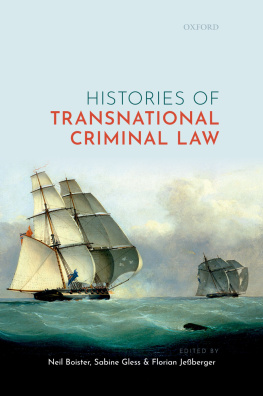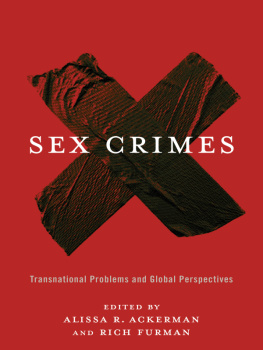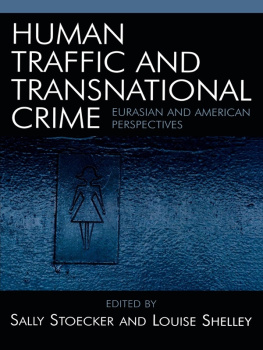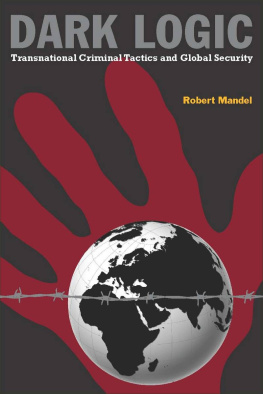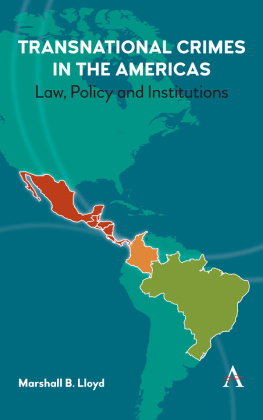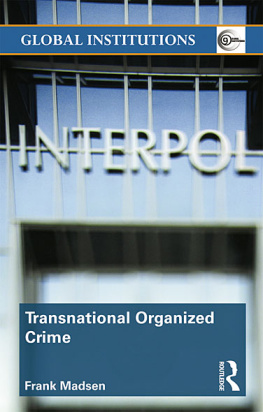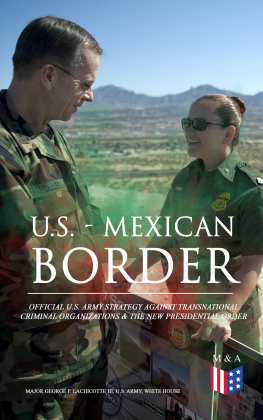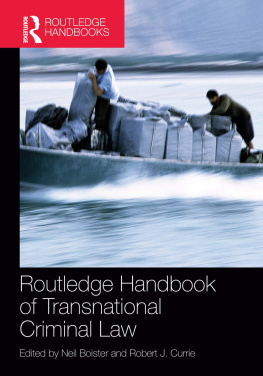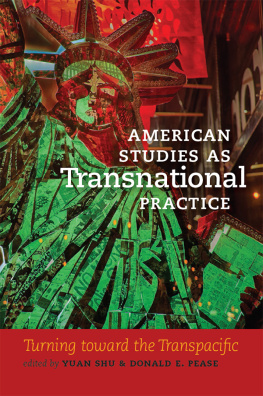Histories of Transnational Criminal Law

Great Clarendon Street, Oxford, OX2 6DP,
United Kingdom
Oxford University Press is a department of the University of Oxford. It furthers the Universitys objective of excellence in research, scholarship, and education by publishing worldwide. Oxford is a registered trade mark of Oxford University Press in the UK and in certain other countries
The Several Contributors 2021
The moral rights of the authors have been asserted
First Edition published in 2021
Impression: 1
All rights reserved. No part of this publication may be reproduced, stored in a retrieval system, or transmitted, in any form or by any means, without the prior permission in writing of Oxford University Press, or as expressly permitted by law, by licence or under terms agreed with the appropriate reprographics rights organization. Enquiries concerning reproduction outside the scope of the above should be sent to the Rights Department, Oxford University Press, at the address above
You must not circulate this work in any other form and you must impose this same condition on any acquirer
Crown copyright material is reproduced under Class Licence Number C01P0000148 with the permission of OPSI and the Queens Printer for Scotland
Published in the United States of America by Oxford University Press
198 Madison Avenue, New York, NY 10016, United States of America
British Library Cataloguing in Publication Data
Data available
Library of Congress Control Number: 2021933265
ISBN 9780192845702
eISBN 9780192660619
DOI: 10.1093/oso/9780192845702.001.0001
Links to third party websites are provided by Oxford in good faith and for information only. Oxford disclaims any responsibility for the materials contained in any third party website referenced in this work.
Foreword
In the not too distant past crime was considered a local matterlocal in commission and effectto be governed by a local response. But with the changes technology has brought to our global landscape, nothing could be further from our reality today. Grave crimes recognized as international in nature, because of the threat they pose, tragically continue to be perpetrated in many corners of the world. Moreover, many crimes once considered domestic in nature now by scope, manner of perpetration or impact have become transnational. Further, individual criminals and organized groups easily traverse borders to evade detection and hide the evidence and profits of their crimes rendering local responses highly ineffective. These realities have driven a multitude of initiatives over the last few decades designed to respond to the internationalization of crime.
Looking back on these with the perspective of a practitioner, I think it fair to say some of the most important outcomes have been in the context of the evolution of a framework to address international crimes which affect us as a global community. Prominent examples are the rapid expansion and development of international criminal law including the establishment of landmark ad hoc courts and tribunals such as the International Criminal Tribunal for the former Yugoslavia, the International Criminal Tribunal for Rwanda and, of course, the first permanent International Criminal Court.
Unquestionably, the developments have been ground-breaking and well merit the attention paid to them on both a practical and academic level. Tragically far too much of the worlds population today is touched by conflictsinsurrections, warswith horrific crimes still being committed in the context of the same. For that, advancing international criminal law is imperative.
At the same time, this highly visible progress has tended to overshadow the equally remarkable achievements in the efforts to find global solutions to combat common crime which by its nature, scope or effect creates a transnational threat. Transnational crime is pervasive, touching all of us in different ways, in every corner of the world, posing a grave threat as well to the safety and security of all our communities. The progression of transnational criminal law is of equal importance in our global village.
For this reason, it is imperative that we shine a light on the significant initiatives and achievements in this lesser known field of transnational criminal law. Careful reflection on where we have been and where we are now, on the progress and the challenges, is fundamental to safeguarding the gains made and ensuring future progression.
With that aim, Histories of Transnational Criminal Law is a seminal work presenting a comprehensive and detailed overview of the substantive fieldsterrorism, organized crime, cybercrime and human trafficking, to name a fewas well as the procedural mechanismsmultilateral suppression, institution building and norm development. Due attention is also paid to the often neglected field of international cooperation in criminal mattersincluding extradition and law enforcement cooperation.
Each chapter provides a discrete overview of a substantive issue or procedural development that can quickly inform a practitioner or researcher with a targeted subject in mind. Collectively the text paints a compelling picture of the global initiative against transnational crime exposing both its success and failures, identifying progress and the challenges we face today and will face in future.
In the course of my career I have participated directly in development of some of the initiatives related to the fight against transnational crime and I worked at the United Nations Office on Drugs and Crime where they formed part of everyday practice. Thus I consider I have a pretty good knowledge base in the field. Yet I can assure you I was captivated by this text. It is a credit of course to the impressive group of scholars and practitioners who have contributed to it. I learnt about subjects I had never considered in the context of this field and as a whole it provided a unique overview of the important interrelated components of this rapidly developing subject area. I invite you to carry out a similar exploration of this important work so relevant in the context of international law and criminal law in our times.
Kimberly Prost
Judge, International Criminal Court
Preface
The book goes back to a conference held in October 2019 at Schloss Herrenhausen in Hannover, Germany. The chapters of this volume are edited papers presented and discussed at this conference. The conference has been made possible through generous funding and administrative support from the Volkswagenstiftung.
We would like to acknowledge the support of the whole team of the Lehrstuhl Jeberger during the conference, in particular of Luca Hauffe. Antonia Gillhaus in Berlin as well as Claudine Abt and Lia Brlin in Basel helped with copy-editing the manuscript. Our gratitude also lies with our publishers, Merel Alstein and Jack McNichol, for their valuable support.
All websites cited in this volume have last been accessed on 1 December 2020.
Christchurch, Basel and Berlin
December 2020
Table of Contents
Neil Boister, Sabine Gless and Florian Jeberger
Karl Hrter
Michele Pifferi
Neil Boister
Kerstin von Lingen
Mangai Natarajan
Frank Meyer
Sara Wharton and Robert J Currie
Masha Fedorova and Piet Hein van Kempen
Roger S Clark
Ben Saul
Heli Askola
Andreas Schloenhardt
Serena Forlati

